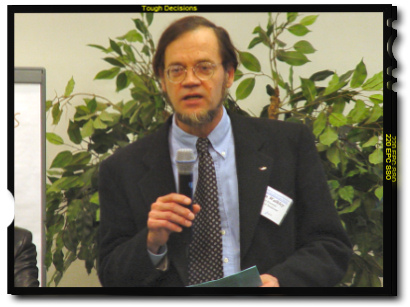Glycoproteinoses: An International Workshop on Advances in Pathogenesis and Therapy, by Steven U. Walkley, V.M.D., Ph.D
Conference Home
Children’s Program
Glycoproteinosis Workshop
Personal Reflections

This scientific workshop was led by Drs. Allesandra d’Azzo and Steven Walkley and attended by approximately 50 scientists from North America, Europe and the Pacific, all with interests and experience in the study of glycoprotein storage diseases. Many family members also attended the scientific sessions.
The meeting began with a series of lectures on how proteins are glycosylated (Dr. S. Kornfeld), how they are eventually degraded in lysosomes (Dr. B. Winchester), and what happens when defects occur in lysosomes which block this normal degradation (Dr. M. Patterson). In Session 2, mechanisms by which the inherited defects in lysosomes actually cause cell dysfunction and disease were explored. Dr. D. Marks, from the laboratory of Dr. R. Pagano, and Dr. S. Walkley spoke of the importance of secondary sequestration of cholesterol and glycosphingolipids and its potential consequences in lysosomal diseases. Dr. A. Cuervo discussed the degradation of cytosolic proteins in lysosomes and of the overall mechanism of chaperone-mediated autophagy. Drs. E. Neufeld and R. Proia discussed their studies on the importance of microglia and brain inflammation as participating in lysosomal disease pathogenesis, as well as possible significant differences between different types of disorders in terms of the microglial-mediated response. Dr. A. d’Azzo spoke of mechanisms contributing to neuron death in the lysosomal disease, GM1 gangliosidosis. Sessions 3 and 4 were focused on discussions of many available animal models of glycoprotein storage diseases as well as molecular mechanisms contributing to individual diseases. Included here were reports of glycoprotein storage diseases in mice, guinea pigs, cats, dogs, goats and cattle, and presentations by Drs. M. Haskins, A. Jalanko, J. Hopwood, D. Schindler, A. d’Azzo, P. Lobel, and W. Sly. There were also 2 sessions of speakers focused on therapeutic strategies in lysosomal diseases. Included here were reports on enzyme replacement therapy in alpha-mannosidosis by Dr. P. Saftig, mechanisms by which microglia may transfer enzyme to diseased neurons by Dr. K. Dobrenis, the use of cord blood and Hematopoietic stem cell transplants by Drs. M. Escolar and C. Peters, respectively, and the use of adenoviral and Lentiviral vectors for gene therapy by Drs. M. Sands and J. Medin, respectively. This session ended with a remarkable report on the use of an adenoviral vector for the treatment of brain disease in an animal model of alpha-mannosidosis by Dr. C. Vite.
Several new investigators to the field were also invited to attend the meeting and present their findings on lysosomal diseases, including Dr. Y-P Wu (mechanisms of inflammation in storage diseases), Dr. C. Tifft (surrogate markers of lysosomal disease progression), Dr. K. Ohmi (the role of gliosis in storage disease), Dr. M. Ellinwood (a newly discovered model of mucopolysaccharidosis type IIIB), Dr. M. Yoshimitsu (the use of Lentiviral vectors in gene therapy), Dr. G. Yogalingam (the use of PPCA as therapy for sialidosis) and Dr. D. Wang (enzyme replacement therapy in sialidosis and galactosialidosis).
The meeting closed with a roundtable discussion of pathogenic mechanisms, animal models, treatment strategies, future research priorities and research collaborations, and funding strategies, chaired by Dr. S. Kornfeld and addressed by Drs. M. Haskins, J. Hopwood, L. Neufeld, D Malm, and W. Sly. Consensus emerged on several points. Firstly, one of the major areas where our knowledge of glycoprotein storage diseases was believed most limited was in the actual mechanisms by which lysosomal dysfunction leads to cell and organ failure, particularly for brain as well as for bone and cartilage. Secondly, the availability of animal models of lysosomal diseases was viewed as a major research resource for both understanding issues of pathogenesis and for evaluating potential therapies. The one notable omission in terms of disease models was of a mouse model of fucosidosis, which many felt would be a major resource that should be developed as soon as possible. Finally, all agreed that the meeting had successfully brought together key leaders in the field, and that many new collaborations had been established and that additional substantial progress in understanding and in treating the glycoproteinoses could be anticipated.
